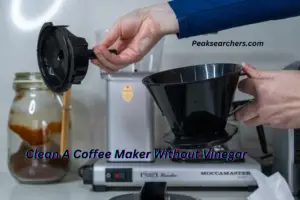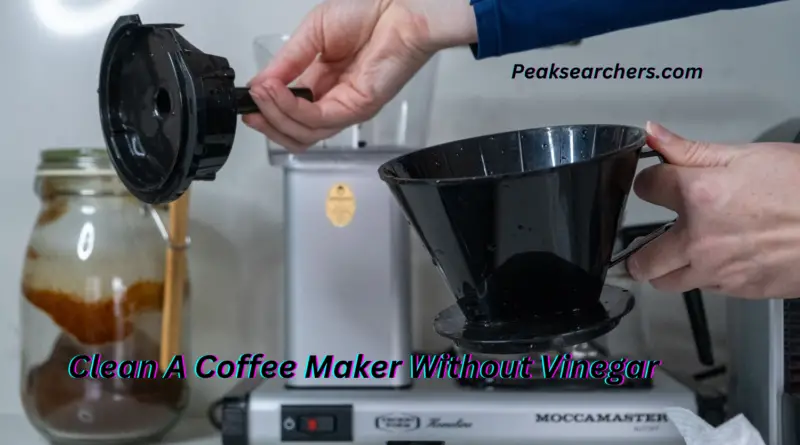How To Clean A Coffee Maker Without Vinegar? A Complete Guide
Cleaning your coffee maker is essential for ensuring that your morning brew tastes its best and remains safe to consume. While vinegar is a popular choice for cleaning coffee makers, some people may not like its strong odor or prefer a vinegar-free option.
I did not know how to clean my coffee maker without vinegar. Then, I searched through the internet and then finally, I was able to do so. I have discussed everything in this article. We will explore alternative methods to clean your coffee maker effectively without the use of vinegar.

Why Avoid Vinegar?
Vinegar is a common cleaning agent used for coffee makers due to its acidity, which helps dissolve mineral deposits and residue.
However, some individuals dislike the strong vinegar smell that lingers even after thorough rinsing. Additionally, some coffee maker manufacturers recommend against using vinegar as it may damage certain internal components over time.
The Importance of Regular Cleaning
Cleaning your coffee maker regularly is crucial to maintain its performance and extend its lifespan. Coffee oils and mineral deposits can build up inside the machine, affecting the taste of your coffee and potentially causing clogs.
A clean coffee maker ensures that each cup you brew is fresh and delicious. You should make sure that you thoroughly clean your home utensils because hygiene is very important for sound health.
If your equipment is dirty, how come you can have good health? So, clean them regularly.
Materials You’ll Need
Before we delve into the cleaning methods, gather the following materials:
- Mild dish soap
- Baking soda
- Lemons (or lemon juice)
- Commercial coffee maker cleaner
- A soft brush or sponge
- Clean, lint-free cloths
- Water
Now, let’s explore three effective methods to clean your coffee maker without vinegar:
Method 1: Baking Soda and Water
Step 1: Preparing the Solution
- You need to fill your sink or you can also use a large basin with warm water.
- Add 1-2 tablespoons of baking soda and mix until dissolved.
Step 2: Cleaning the Coffee Pot and Filter Basket
- Submerge the coffee pot and filter basket in the baking soda solution.
- Let them soak for about 15 minutes.
- After that, you need to use a soft brush or sponge to scrub away any residue.
- Rinse thoroughly with clean water.
Step 3: Running the Solution Through the Coffee Maker
- Fill the coffee maker’s water reservoir with the remaining baking soda solution.
- Start a brew cycle without coffee grounds.
- After the cycle is complete, discard the solution.
Step 4: Rinsing and Drying
- Rinse the coffee pot and filter basket with clean water until all traces of baking soda are gone.
- Dry the components thoroughly before reassembling your coffee maker.
Method 1 is a simple and effective way to clean your coffee maker without vinegar. Now, let’s explore another vinegar-free method:
Method 2: Lemon Juice
Step 1: Mixing Lemon Juice and Water
- Squeeze the juice from two fresh lemons.
- Then, you need to mix the lemon juice with an equal amount of water.
Step 2: Cleaning the Coffee Maker
- Pour the lemon juice solution into the water reservoir.
- Start a brew cycle without coffee grounds.
- Once the cycle is finished, discard the lemon solution.
Step 3: Rinsing and Final Touches
- Run two cycles of clean water through the coffee maker to remove any lingering lemon scent.
- Then, simply wipe the exterior of the coffee maker with a clean soft cloth.
Method 2 not only effectively cleans your coffee maker but also leaves it smelling fresh. For those who prefer ready-made solutions, we have an alternative method:
Method 3: Commercial Coffee Maker Cleaners
Step 1: Selecting the Right Cleaner
- Read the instructions on the coffee maker cleaner product.
- Follow the manufacturer’s recommendations for dilution.
Step 2: Cleaning with the Product
- Prepare the cleaner solution as instructed.
- In the next step, fill the coffee maker’s water reservoir with the solution.
- Run a brew cycle without coffee grounds.
- Discard the solution.
Step 3: Rinsing Thoroughly
- Run at least two cycles of clean water through the coffee maker to remove any residual cleaner.
- Dry the coffee maker components thoroughly.
Using a commercial coffee maker cleaner is a convenient option for those who prefer a hassle-free approach to cleaning.
Maintaining Your Coffee Maker
To keep your coffee maker in top condition, consider these maintenance tips:
Cleaning the Carafe and Filter Basket Daily
- Rinse the carafe and filter basket after each use to prevent the buildup of coffee oils and residue.
Monthly Deep Cleaning Routine
- In addition to regular cleaning, perform a deep cleaning of your coffee maker using one of the methods mentioned above at least once a month.
Tips and Tricks
Removing Hard Water Deposits
- If your coffee maker has mineral deposits, soak the affected parts in a mixture of vinegar and water overnight, then rinse thoroughly.
Cleaning the Exterior
- Wipe down the exterior of your coffee maker with a damp cloth regularly to prevent dust and grime buildup.
Frequently Asked Questions
Can I use citric acid instead of lemon juice?
Yes, you can substitute citric acid for lemon juice following the same proportions mentioned in Method 2. If we discuss the citric acid, it is an effective natural cleaner.
How often should I clean my coffee maker?
It’s best to clean your coffee maker after every use, with a deep cleaning once a month.
Is it safe to use bleach to clean a coffee maker?
We do not recommend using bleach, as it can leave behind harmful residues and affect the taste of your coffee.
Can I put my coffee maker parts in the dishwasher?
Check the manufacturer’s instructions; some parts may be dishwasher-safe, while others should be hand-washed.
What if my coffee maker has a self-cleaning feature?
You can still follow these cleaning methods periodically to ensure thorough maintenance, as self-cleaning features may not address all areas.
Also read: How To Use Mr. Coffee Maker? A Step By Step Guide
Conclusion
A clean coffee maker is essential for brewing delicious coffee. By following the methods outlined in this guide, you can effectively clean your coffee maker without vinegar. Whether you choose baking soda, lemon juice, or a commercial cleaner, regular maintenance will ensure your coffee always tastes its best.
If you are still facing the same issue, then you can try contacting the official support of the coffee maker. You can also ask us in the comments section.


